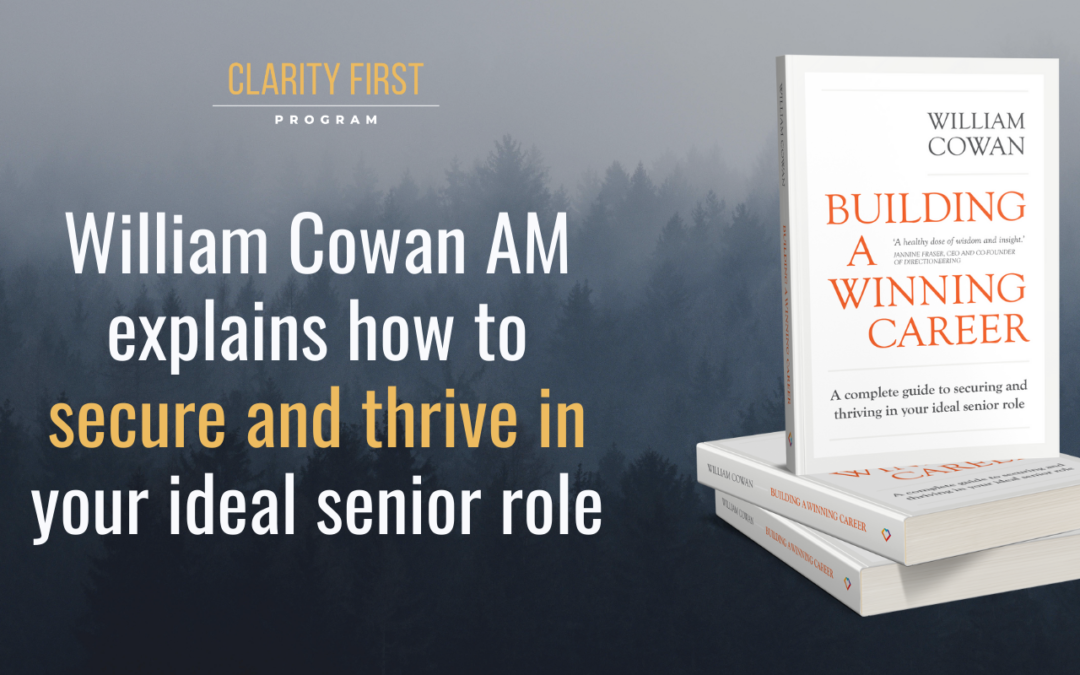×

LEARN MORE ABOUT THE WORKSHOP KIT
Enter your email below and we will keep you updated as more information is released about the kit.

Well, Bill certainly did not disappoint in this morning's interview!
Bill shared career insights that are hugely relevant to all of us, no matter where we are in our careers.
He gave me a new idea for addressing current challenge and judging by the chat messaging others found the same.
I encourage you to take the time to watch the recording below and to consider working with him further.
Grab a copy of his new book Building a Winning Career, which launched today. He is offering the Kindle version for about $10 for the coming two weeks to make it affordable to everyone, as well as physical copies which Australians can order directly from him, or those overseas can access via online book stores.

I love what I do.
I help senior leaders and their teams prepare high-quality papers and presentations in a fraction of the time.
This involves 'nailing' the message that will quickly engage decision makers in the required outcome.
I leverage 25+ years' experience including
My approach helps anyone who needs to engage senior leaders and Boards.
Recent clients include 7Eleven, KPMG, Mercer, Meta, Woolworths.
Learn more at www.clarityfirstprogram.com
(*) Numbers are based on 2023 client benchmarking results.

Have your senior leaders ever told you they have been ‘swept away' by your recent paper?
It was a first for my client, a Chief of Staff at a national brand too. She was thrilled when her Chief Legal Officer said he was ‘swept away' by her recent SLT paper.
Nobody had ever said something like that about her communication before.
This drew out a fabulous discussion about the difference between being ‘clear' and being ‘compelling' in our communication.
If we communicate clearly, our audience understands us with relative ease.
If we communicate in a way that is compelling, our audience is engrossed in our material. Swept away, even.
But, how to make the shift from being understood, to sweeping our audience away?
It helps to understand what I call the value ladder, which describes the difference between the value individual statements within our communication offer.

It sounds like my client was operating at the ‘artistry' level.
Here's a challenge for you: take a look at the last few papers you have delivered.
I hope that helps. Have a great week.
Warm regards,
Davina
Episode 1 – Avoiding common communication traps
Episode 2 – Communicating insight vs information
Episode 3 – Delivering communication is the easy part
Episode 4 – The value of thinking top down
Episode 5 – How to get the information you need to deliver powerful communication
Episode 6 – How to collaborate for greater clarity and productivity
Please do tell your friends and colleagues about them too.

I love what I do.
I help senior leaders and their teams prepare high-quality papers and presentations in a fraction of the time.
This involves 'nailing' the message that will quickly engage decision makers in the required outcome.
I leverage 25+ years' experience including
My approach helps anyone who needs to engage senior leaders and Boards.
Recent clients include 7Eleven, KPMG, Mercer, Meta, Woolworths.
Learn more at www.clarityfirstprogram.com
(*) Numbers are based on 2023 client benchmarking results.

When talking about the risks in a recent Board paper with two SLT members, one of them said something very interesting.
The risks section SHOULD make us feel uncomfortable.
The CTO's view was that if we highlight the things that are keeping us up at night and can demonstrate how well we have thought them through they will trust us more.
I found this interesting as I at times see risks being discussed in a ‘tick a box' fashion or alternatively being played down to reduce political rather than practical risk.
Given his view was so clear and strong vs what I so often see, I wanted to unpack his reasoning to help you too …
If we do share what keeps us up at night three things will happen. We
If, alternatively, we are ‘gilding the lily' by only discussing the positives, leaders won’t trust us – and neither they should.
In his words: if we play it safe we would let both them and ourselves down as it demonstrates that we
This was food for thought to me and will push me to focus more intently on how risks are articulated in communication I help my clients prepare.
What about you?
How openly do you discuss the risks as you see them when lying awake at night?
I hope that helps. More next week.
Kind regards,
Davina

I love what I do.
I help senior leaders and their teams prepare high-quality papers and presentations in a fraction of the time.
This involves 'nailing' the message that will quickly engage decision makers in the required outcome.
I leverage 25+ years' experience including
My approach helps anyone who needs to engage senior leaders and Boards.
Recent clients include 7Eleven, KPMG, Mercer, Meta, Woolworths.
Learn more at www.clarityfirstprogram.com
(*) Numbers are based on 2023 client benchmarking results.

Many companies are moving away from physical paper for board papers in favour of tablets.
Directors seem generally grateful not to take phone-book sized packs away for their weekend reading and all would agree that less paper is usually better. However, transitioning to tablets is more complex than it seems.
Today's ‘Tips & techniques for board writing on iPads & tablets' session presented by Mary Morel of Write to Govern and hosted by the Governance Institute of Australia highlighted that point.
In coming away from that session, I realised that coming to grips with the technology is not as easy as it seems, macro structure matters most of all, visual presentation matters more than in the past and micro issues matter more than you might think. Here is some more on each of these points:
Coming to grips with the technology is not as easy as it seems
Macro structure matters most of all
Visual presentation of information matters even more than in the past
Micro matters more than you might think
Keywords – #board papers #deliver your communication #board communication
I came across a terrific article in the Australian Financial Review today that quotes two of Australia's most prominent board directors, Catherine Livingstone and David Gonski.
They had a thing or two to say at a recent education conference, which I thought might interest you too.
They suggested that rather than teaching our young people to code, we first need to teach them to think.
I drew three core ideas from the article:
Livingstone said: “I get quite taken aback sometimes when I see something written or proposed, on the lack of logic in developing an argument”.
Gonski added: “We have to have a broadness and openness … knowledge is important but the analysis of knowledge has to be taught.”
So, while a lot of attention is paid to polishing the delivery of our communication, it seems to me Australia's top decision makers are crying out for a clear and logical argument.
To learn how to communicate complex ideas in a way that resonates with senior leaders, check out Clarity First. It's our speciality.

I love what I do.
I help senior leaders and their teams prepare high-quality papers and presentations in a fraction of the time.
This involves 'nailing' the message that will quickly engage decision makers in the required outcome.
I leverage 25+ years' experience including
My approach helps anyone who needs to engage senior leaders and Boards.
Recent clients include 7Eleven, KPMG, Mercer, Meta, Woolworths.
Learn more at www.clarityfirstprogram.com
(*) Numbers are based on 2023 client benchmarking results.